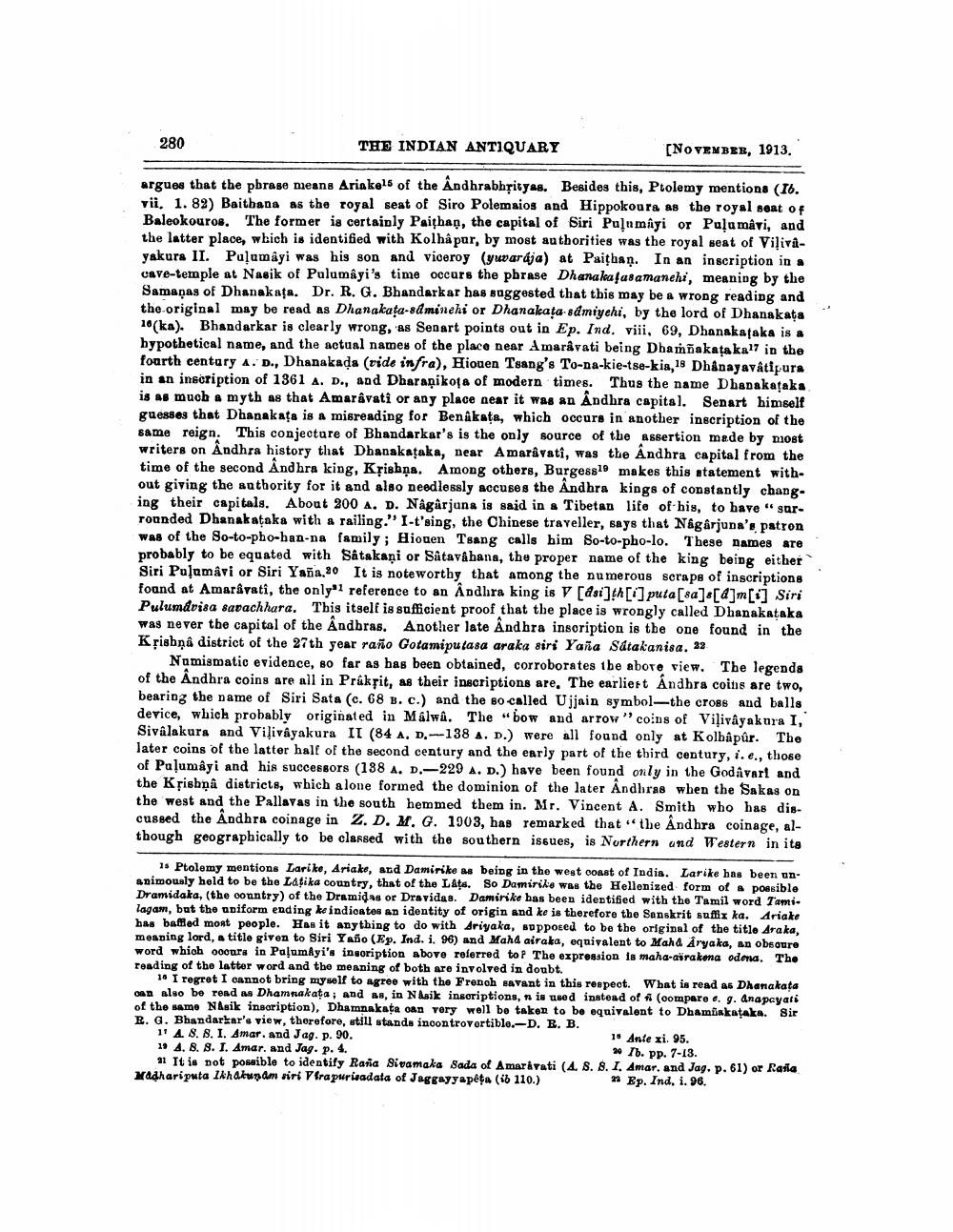________________
280
THE INDIAN ANTIQUARY
[NOVEMBER, 1913.
argues that the pbrase means Ariakels of the Andhrabhsityas. Besides this, Ptolemy mentions (16. vii, 1. 82) Baitbana as the royal seat of Siro Polemaios and Hippokoura as the royal seat of Baleokouros. The former is certainly Paithan, the capital of Siri Paļumiyi or Palumâri, and the latter place, which is identified with Kolhapur, by most authorities was the royal seat of Viļivayakura II. Pulumâyi was his son and viceroy (yuvarája) at Paithan. In an inscription in a Cave-temple at Nasik of Palumâyi's time occurs the phrase Dhanakafasamanehi, meaning by the Samaņas of Dhanakața. Dr. R. G. Bhandarkar has suggested that this may be a wrong reading and the original may be read as Dhanakata-8dminehi or Dhanakata-sámiyehi, by the lord of Dhanakata 10(ka). Bhandarkar is clearly wrong, as Senart points out in Ep. Ind. viii, 69, Dhanakataka is a hypothetical name, and the actual names of the place near Amaravati being Dhamñakata kal7 in the fourth centary A. D., Dhanakada (vide infra), Hionen Tsang's To-na-kie-tse-kia, 18 Dhanayavâtipura in an inscription of 1361 A. D., and Dharaņikoja of modern times. Thus the name Dhadakataks is as much a myth as that Amaravati or any place near it was an Andhra capital. Senart himself guesses that Dhanakata is a misreading for Benakata, which occurs in another inscription of the same reign. This conjecture of Bhandarkar's is the only source of the assertion made by most writers on Andhra history that Dbanakataka, near Amarîyatî, was the Andhra capital from the time of the second Andhra king, Kțiskņa. Among others, Burgesso makes this statement without giving the authority for it and also needlessly accuses the Andhra kings of constantly change ing their capitals. About 200 A. D. Nagarjuna is said in a Tibetan life of his, to have "gar. rounded Dhanakataka with a railing." I-t'sing, the Chinese traveller, says that Nagarjuna's patron was of the So-to-pho-ban-na family ; Hionen Tsang calls him So-to-pho-lo. These names are probably to be equated with Såtskaņi or Satavahana, the proper name of the king being either Siri Polomâri or Siri Yaña 20 It is noteworthy that among the numerous scrape of inscriptions found at Amaravati, the only reference to an Andhra king is [asi]th[ puta[80][0][0] Siri Pulumdrisa savachhara. This itself is sufficient proof that the place is wrongly called Dhanakataka was never the capital of the Andbras. Another late Andhra insoription is the one found in the Krisbņa district of the 27th year raño Gotamiputasa araka siri Yaña sátakanisa. 22
Numismatic evidence, so far as bas been obtained, corroborates tbe above view. The legends of the Andhra coins are all in Práksit, as their inscriptions are. The earliert Andhra coins are two, bearing the name of Siri Sata (c. 68 B. c.) and the so called Ujjain symbol--the cross and balls device, which probably originated in Malwa. The bow and arrow' coins of Viļivâyakura I, Sivalakura and Viļivayakura IL (84 A. D.-138 A. D.) were all found only at Kolbâpûr. The later coins of the latter hall of the second century and the early part of the third century, i.e., those of Paļumâyi and his successors (138 A. D.-229 A. D.) have been found only in the Godavart and the Kșishņa districts, which alone formed the dominion of the later Andhras when the Sakas on the west and the Pallavas in the south hemmed them in. Mr. Vincent A. Smith who has discussed the Andhra coinage in Z.D. M, G. 1903, has remarked that the Andhra coinage, although geographically to be classed with the southern issues, is Northern and Western in its
1s Ptolemy mentions Larike, Ariake, and Damirike as being in the west coast of India. Larike has been un. animously held to be the Latika country, that of the L&ts. So Damiride was the Hellonized form of possible Dramidaka, (the country) of the Dramidas or Dravidas. Damirike has been identified with the Tamil word Tamilagam, but the uniform ending ke indicates an identity of origin and ke is therefore the Sanskrit suffix ka. Ariake has baffled most people. Has it anything to do with Ariyaka, supposed to be the original of the title Araka, meaning lord, a title given to Siri Yaño (Ep. Ind. i. 96) and Mahd airaka, equivalent to Mahd Aryaka, an obscure word which ooours in Palumáyi's insoription above referred to The expression is maha-ajrakona odena. The reading of the latter word and the meaning of both are involved in doubt.
16 I regret I cannot bring myself to agree with the French savant in this respect. What is read as Dhanakata 010 also be rend as Dhamnakata and as, in Nasik inseriptions, no is used instead of * (compare e. 9. Anapeyati of the same Nasik insoription), Dhamakata oan very well be taken to be equivalent to Dhamakataka. Sir R. G. Bhandarkar's view, therefore, still standa incontrovertiblo.-D. E. B. 11 A 8. 8. I. Amar. and Jag. p. 90.
1. Ante zi. 95. 19 A. B. S. I. Amar. and Jag. p. 4.
lb. pp. 7-13. 11 It is not possible to identify Rasia sivamaka Sada of Amarivati (4. 8. 8. I. Amar, and Jag. p. 61) or Rasia Madhariputa Ikhatunam siri frapurisadata of Jaggayyapeta (ib 110.)
2 Ep. Ind. i. 96.




